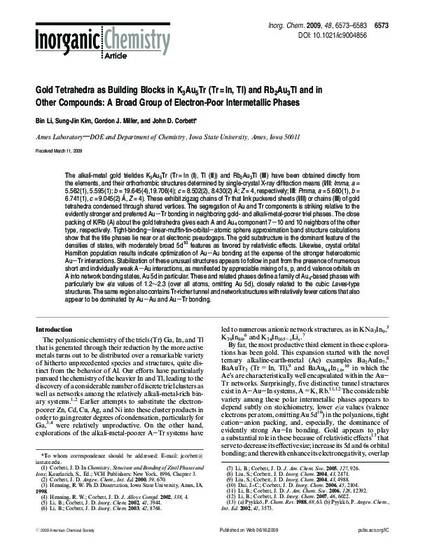
The alkali-metal gold trielides K3Au5Tr (Tr = In (I), Tl (II)) and Rb2Au3Tl (III) have been obtained directly from the elements, and their orthorhombic structures determined by single-crystal X-ray diffraction means (I/II: Imma, a = 5.562(1), 5.595(1); b = 19.645(4),19.706(4); c = 8.502(2), 8.430(2) Å; Z = 4, respectively; III: Pmma, a = 5.660(1), b = 6.741(1), c = 9.045(2) Å, Z = 4). These exhibit zigzag chains of Tr that link puckered sheets (I/II) or chains (III) of gold tetrahedra condensed through shared vertices. The segregation of Au and Tr components is striking relative to the evidently stronger and preferred Au−Tr bonding in neighboring gold- and alkali-metal-poorer triel phases. The close packing of K/Rb (A) about the gold tetrahedra gives each A and Au4 component 7−10 and 10 neighbors of the other type, respectively. Tight-binding−linear-muffin-tin-orbital−atomic sphere approximation band structure calculations show that the title phases lie near or at electronic pseudogaps. The gold substructure is the dominant feature of the densities of states, with moderately broad 5d10 features as favored by relativistic effects. Likewise, crystal orbital Hamilton population results indicate optimization of Au−Au bonding at the expense of the stronger heteroatomic Au−Tr interactions. Stabilization of these unusual structures appears to follow in part from the presence of numerous short and individually weak A−Au interactions, as manifested by appreciable mixing of s, p, and d valence orbitals on A into network bonding states, Au 5d in particular. These and related phases define a family of Au4-based phases with particularly low e/a values of 1.2∼2.3 (over all atoms, omitting Au 5d), closely related to the cubic Laves-type structures. The same region also contains Tr-richer tunnel and network structures with relatively fewer cations that also appear to be dominated by Au−Au and Au−Tr bonding.
Available at: http://works.bepress.com/gordon-miller/48/

Reprinted (adapted) with permission from Inorg. Chem., 2009, 48 (14), pp 6573–6583. Copyright 2009 American Chemical Society.